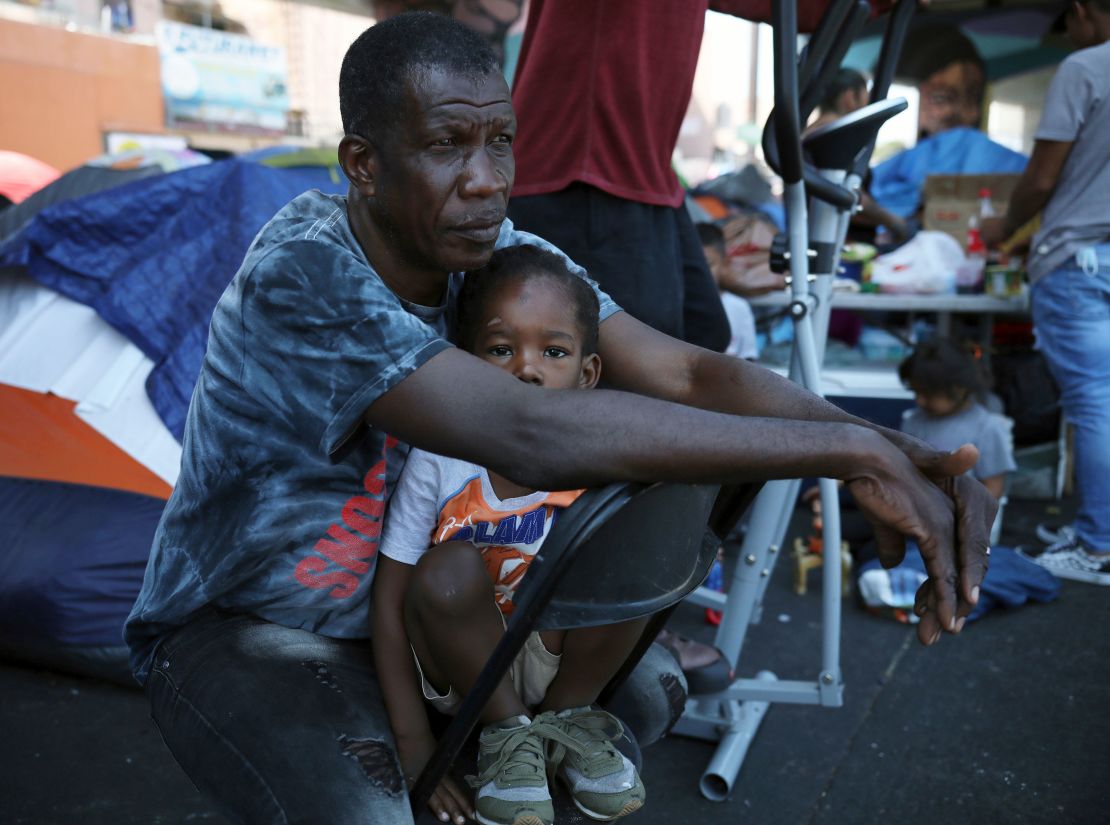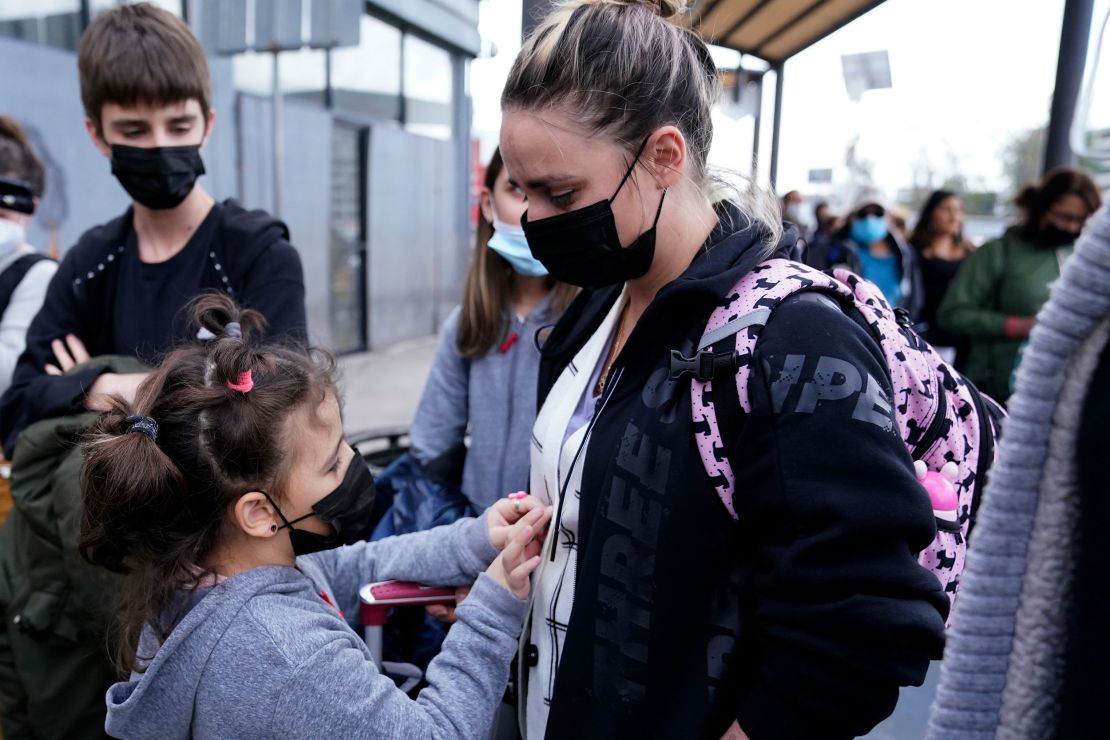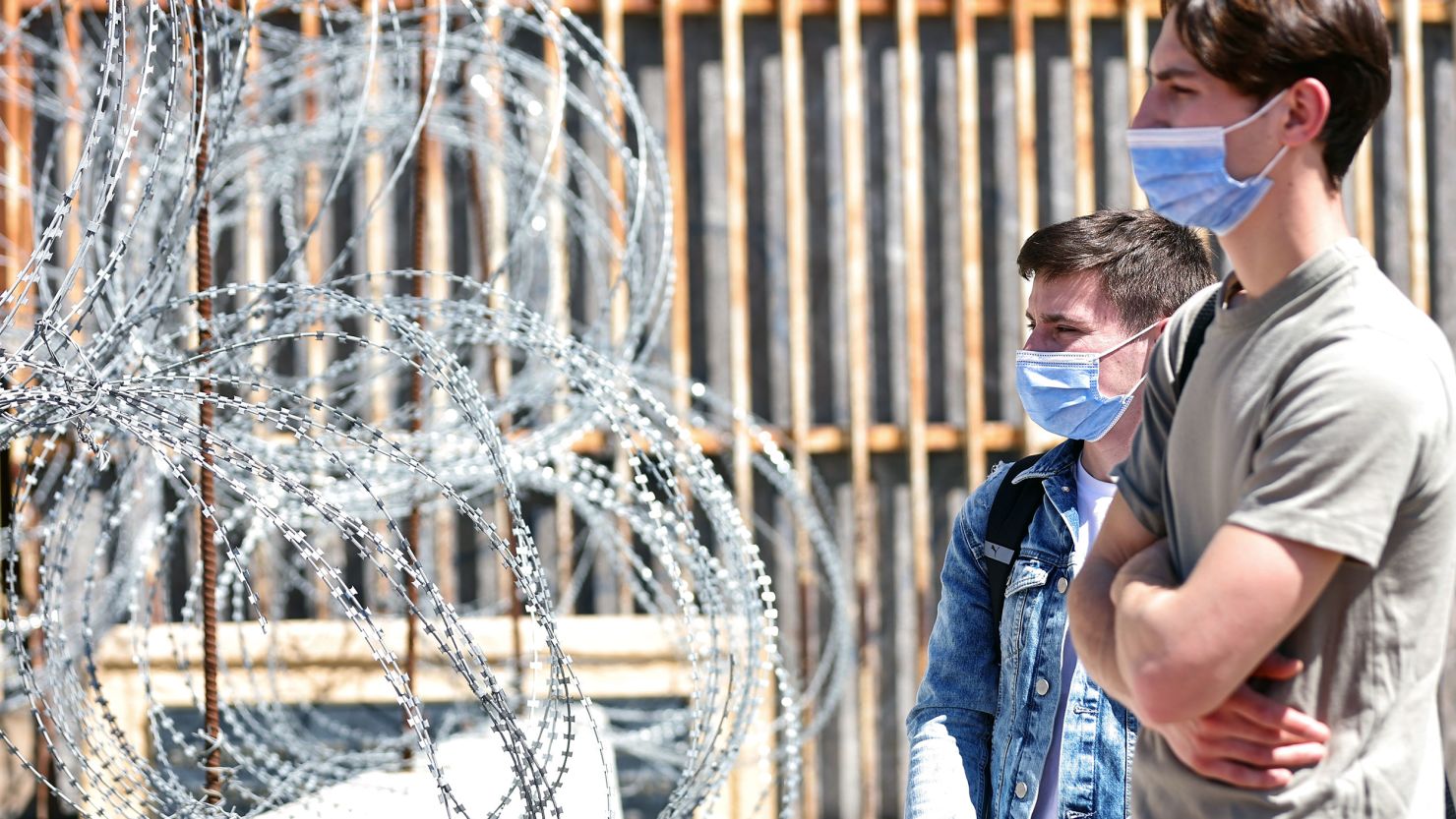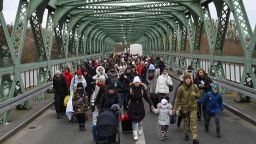Groups of Ukrainian families at the US-Mexico border are getting the chance to do something most asylum-seeking migrants haven’t been allowed to do for years: cross legally into the United States.
A memo obtained by CNN instructs officers at the border to consider exempting Ukrainians on a case-by-case basis from the public health restrictions the US has used to block migrants from entering the country since the early days of the pandemic.
It’s significant that only Ukrainians were singled out in the recent Department of Homeland Security memo.
And it’s drawing attention from some immigrant rights advocates, who argue the way the US government is responding to the arrival of Ukrainians illustrates how political the US immigration system can be and highlights a racist double standard in how the US treats migrants.
“The disparate treatment is really mind-blowing. The cases that we’ve seen denied for Black and brown migrants are life-and-death cases,” says Erika Pinheiro, litigation and policy director of Al Otro Lado, an organization that provides aid to migrants and refugees. “We’re talking children who might die are being denied entry.”
Pinheiro and other advocates who spoke with CNN stress that Ukrainians fleeing war deserve the chance to seek safety in the United States. But so do many others in desperate circumstances.
“We support and welcome the Ukrainian community,” says Guerline Jozef, executive director of the Haitian Bridge Alliance. “Our goal is to be able to make sure that the same humanity that is being afforded to our Ukrainian community members is afforded to other people as well.”
What witnesses describe at the border
Asked about allegations of a double standard, a DHS spokesperson says exemptions to the public health restrictions at the border have been – and still are – granted on a case-by-case basis “to particularly vulnerable individuals of all nationalities for humanitarian reasons.”
The memo that suggests considering Ukrainians for exemptions notes that “the unjustified Russian war of aggression in Ukraine has created a humanitarian crisis.”
Advocates say they’ve seen an uptick in Ukrainians showing up at the US-Mexico border over the past year. But the numbers are still far smaller than the millions of Ukrainian refugees who’ve been fleeing to European countries.
These Ukrainians trying to reach the United States have generally flown to Mexico, where it’s easy to obtain a visa to travel, and then gone to ports of entry along the US southern border, Jessica Bolter of the Migration Policy Institute told CNN earlier this month.

From October 2021 through February, CBP encountered just over 1,300 Ukrainians along the US southern border, according to agency data. Once taken into custody, the Ukrainians have largely been processed and allowed to remain in the US while they pursue their asylum claims.
We don’t yet have official statistics about how many Ukrainians have been allowed to cross at ports of entry in the past month – or how that data compares to other nationalities. DHS declined to provide that data to CNN, stating that those numbers will be released next month.
But in recent weeks, lawyers and advocates who work with migrants at the border say they repeatedly saw US authorities letting Ukrainians cross while turning away people of other nationalities. A CNN team in Tijuana also recently saw several Ukrainian families allowed to cross after being turned away earlier, while two Russian couples said they were turned away and told to wait.
She sees skin color as ‘a major factor’
For weeks human rights advocates and reporters who’ve documented the treatment of refugees in Europe have noted how many countries rolling out the welcome mat for Ukrainians have been indifferent at best, and hostile at worst, to Syrian refugees and others seeking safety.
Now advocates who work along the US-Mexico border are making similar observations.
Jozef says she couldn’t help but think of the disparities when she saw the new guidance issued about Ukrainians at the border, and how quickly the US government granted humanitarian deportation protection to Ukrainians.
She thought of the many Haitians she says have been stuck in Tijuana – some for months, some for years – facing discrimination and dangerous living conditions but blocked from crossing the border and getting help. She thought of the many thousands of other Haitians who’ve been sent back on deportation and expulsion flights since President Biden took office. And she thought of Cameroonians, their country also devastated by war, who’ve been pushing for the same humanitarian deportation protections for more than a year.

“The little boy from Ukraine is a hero, but what of the 11-year-old from Haiti?” she says. “Skin color unfortunately is a major factor in who gets protected … Why do we have to continuously beg for validation of our humanity?”
Many Haitians, she says, have been forced to flee circumstances – including extreme poverty and violent crime – that she views as just as devastating as a military invasion.
“We have entire neighborhoods displaced due to gang and political violence…in addition to natural disasters and climate change,” she says.
Russians also have recently been turned away
In recent days at a border crossing in Tijuana, as an increasing number of Ukrainians and Russians have showed up, Erika Pinheiro says the scene has been striking.
“Once the Ukrainians and Russians get to Mexico, they help each other,” she says. “To me it’s really touching to see that, because they’re putting aside the fact that their countries are in conflict to keep each other safe.”
Ukrainian families, Pinheiro says, were generally allowed to cross in recent days, while migrants from numerous other countries were turned away. That included dozens of Russians, who camped near the port of entry and hoped officials would eventually let them through.

When a CNN team spoke with some of the Russians who’d been turned back at the border earlier this month, they said they feared persecution after speaking out against Russian President Vladimir Putin’s government.
Pinheiro says the Russians were eventually forced to leave their encampment but were later allowed to cross the border. Other media reports have emerged in recent days of Russians being turned away.
DHS declined to provide data on how many Russians have been permitted to cross over the past month, or how many have been turned back, stating that those numbers would be released next month.
A public health policy at the border has led to more than 1 million expulsions
The Trump administration announced public health restrictions at its borders with Mexico and Canada in March 2020, claiming that the coronavirus pandemic made it necessary to block migrants from entering the country to prevent the spread of Covid-19.
Since then, under the policy, known as “Title 42” for the US code invoked in its implementation, authorities say they’ve expelled would-be migrants at the border more than 1.7 million times. Exactly how many people have been impacted isn’t clear, since that figure includes people who’ve tried multiple times to cross.
Since its inception, immigrant rights groups have been decrying Title 42 as racist and xenophobic. They’ve argued officials are using the pandemic as a pretext to block migrants from seeking asylum in the United States – and that the vast majority of those impacted are people of color.
There’s been increasing pressure from immigrant rights groups and Democratic lawmakers to end it.
But the policy remains in place more than a year into Biden’s presidency. Recently behind the scenes, as the pandemic landscape evolves, discussions in the Biden administration about terminating the public health order have picked up speed, three sources familiar with the discussions told CNN.
Advocates argue it’s long past time to end the policy and overhaul the way migrants are being treated at the border, but it’s unclear whether that will happen any time soon.
We’ve seen disparate treatment of immigrants from different countries before
In the complex US immigration system, global politics are among many factors shaping the decisions officials make. And the United States has a long history of disparate treatment of immigrants from different parts of the world.
Sometimes policies have favored refugees from certain countries over others.
For decades, Cubans who stepped foot on US soil were immediately deemed to be in the country legally, no matter how they got here, with government policies granting them benefits like food stamps, Medicaid, housing assistance and work permits soon after their arrival. The Obama administration ended that policy in 2017.
Just last year, as Kabul fell under Taliban rule, the United States airlifted more than 70,000 Afghans into the country as part of Operation Allies Welcome.
In the 1980s, the US rejected many asylum applications from Central Americans fleeing right-wing governments backed by the United States. Religious leaders at the time formed the Sanctuary Movement to protect Salvadorans and Guatemalans from deportation when the US government failed to grant them refuge.
In addition to political considerations, advocates along the US-Mexico border say it’s impossible to ignore how race affects the way policies are shaped and laws are enforced.
Two families, two different responses at the border
Blaine Bookey says she’s currently representing two families who illustrate how differently cases at the border can be handled.
In one recent instance, she says she met a Ukrainian woman at the border who was crying after she and her three children were turned back.
Bookey, legal director of the Center for Gender and Refugee Studies in San Francisco, helped bring publicity to the case and says she also filed a written request to officials asking them to let the family cross.
As media coverage and public pressure mounted, that woman and her children were allowed to cross the next day, Bookey says. Now they’re living with family members in California, she says, and trying to sort out their next steps in the United States.

But Bookey says a Haitian family she met in Tijuana “in very similar circumstances” hasn’t been as lucky.
They were also fleeing dangerous conditions in their home country, she says, and also have family in the United States ready to receive them.
But late last year, before the Ukrainian family had even set out on their journey, the three Haitian children and their parents were turned away at the border after arriving, Bookey says. Recently, with Bookey’s help, they filed a new request for an exemption.
They remain stuck in Tijuana with no end in sight.
One daughter is suffering from a worsening skin condition, Bookey says, and needs medical attention.
“They’re not doing very well at all. They’re living in a shelter that’s totally squalid conditions. The daughter is really suffering. She’s crying, not sleeping. She has an infection and fevers,” Bookey says.
Why one advocate sees signs of hope
Bookey and other advocates who spoke with CNN stress that Ukrainians fleeing war and Russians fleeing a repressive government deserve the chance to seek safety in the United States.
“You see this kind of swift recognition of Ukrainians. We’re really happy about that. That was the right call,” Bookey says. “But then there’s all these other families that have been languishing there for months, some of which are even in more dire circumstances.”
Pinheiro says she sees signs of hope in the way officials appear to be handling Ukrainians’ cases.
“It demonstrates what’s possible when Americans can come together to welcome refugees,” she says.
The system, she says, actually could work for everyone. She hopes that soon it will.
CNN’s Priscilla Alvarez and Lucy Kafanov contributed to this report.





